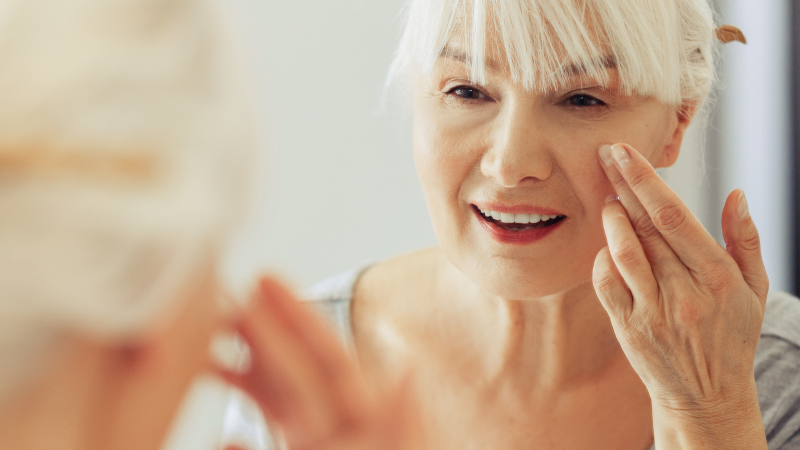Daily Archives: March 16, 2022
“I’m still hot. It just comes in flashes.”

Menopause sucks! It’s depressing enough that I can’t get into my skinny jeans anymore, no matter how much I jump, wriggle, and kick my legs into them. But along with the weight gain are a multitude of other symptoms — irritability, hot flashes, unwanted facial hair, and chaos on my skin. Waah!
No wonder most women dread and worry so much about this time in their life.
During our reproductive years, the hormone estrogen helped keep our skin healthy and supple. As hormone levels plummet, our skin can exhibit Increased dryness, age spots and pigmentation, loss of tone and elasticity, acne, increased sensitivity (likely to lead to rashes and irritations) and increased bruising. Oh, what fun!
All annoying conditions but for this article I want to focus on the menopausal skin issue I get the most question about… pigmentation. If you’ve spent time in the sun (and who hasn’t by age 50?), you’ll likely see age spots and other signs of sun-damage on your face, hands, neck, arms, or chest appearing at this time.
Let’s take a look at the different types of pigmentation caused by hormonal changes.
Melasma
Also known as “chloasma,” or the “pregnancy mask,” melasma is a common pigmentation disorder that causes brown or gray patches, primarily on the face, most often seen in pregnant and menopausal women. Hormonal birth control and Addison’s disease can cause the condition too. It has even been established that intense heat, with or without sun exposure, can create this type of pigmentation on the chin, nose, upper lip, cheeks, and forehead.
Age spots
Estrogen plays a part in the regulation of melanin, the pigment that gives our skin its color and protects it from the harmful rays of the sun. During menopause the decrease of estrogen that occurs can lead to decreased production of melanin. And with lowered melanin production, our skin can become more susceptible to sun damage such as age spots, also known as sunspots or liver spots.
Pigmentation can be very difficult to get rid of. But with a combination of the right ingredients, and sun protection, great results can be accomplished.
Here are a few excellent ingredients that can help to minimize and fade these types of skin discolorations.
Vitamin C, also known as ascorbic acid, is vital for the production of collagen and elastin in the skin. It is an antioxidant, meaning it protects skin cells from damaging free radicals caused by UV exposure. By inhibiting melanin production, it helps to lighten hyperpigmentation and brown spots, even out skin tone and add radiance.
Retinol is a vitamin-A derivative that is used to treat a wide variety of skin issues, including acne and wrinkles. It’s helpful for hyperpigmentation because it encourages cell turnover and over time can thicken the skin surface.
The traditional retinol, however, can cause irritation on some skins. A newer form, Granactive retinol, can also increase cell turnover and increase the rate at which new healthy skin cells migrate to the surface without irritation. And it gives the skin the same smooth and healthy appearance.
Bakichiol is an antioxidant found in the Psoralea Corylifolia plant and is a natural alternative to Retin A. It’s not a Vitamin A derivative and does not cause any irritation so it’s ideal for those with sensitive skin.
Niacinamide, also known as vitamin B3, works as an efficient skin lightening agent because it disrupts the transfer of melanosomes, or pigment structures, in the skin cells, in essence reversing excessive pigment production in the skin.
Kojic Acid, derived from fungi and other plant-based sources during fermentation, is a highly effective skin brightener that can treat melasma, acne scars and sunspots by boosting antioxidant activity.
Arbutin is a naturally occurring derivative of hydroquinone, one of the most commonly prescribed treatments for hyperpigmentation. While hydroquinone is a highly effective ingredient, it’s also rife with side effects and can only be used under stringent medical supervision and for short periods of time.
Its gentler sister, arbutin, is considered one of the best natural alternatives. Like most lightening agents, it works by inhibiting tyrosinase — and does so with just about no reported risks.
Tranexamic Acid is a water-soluble synthetic ingredient derived from the amino acid lysine. It has demonstrated a promising ability to reverse discoloration. It’s gentle enough for sensitive skin types but must be used with oil-soluble ingredients, like niacinamide and vitamin C.
Mulberry Extract has the ability to lower melanin production that occurs as a result of UV exposure. When used as a skin lightener, mulberry extract can even skin tone.
To ensure longer lasting benefits from the above ingredients, apply a broad-spectrum sunscreen with SPF 30 or higher every day to your face, hands, neck, and any other area that clothing won’t cover, even in wintertime.
Far from being the end of life, we can find menopause to be a wonderful new beginning, one that can be lived richly, fully, and with glowing, blemish-free skin.
For more skincare tips, call us at Skinsense Wellness at (323) 653–4701, or check out my other blogs. And for skincare services, please visit us at 8448 W. Third Street, Los Angeles, CA 90048. We will be happy to see you.



